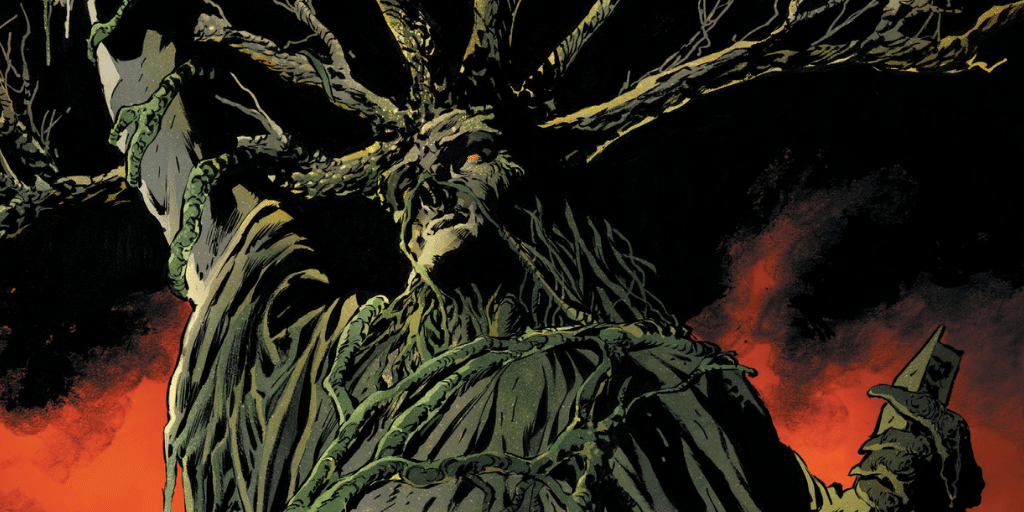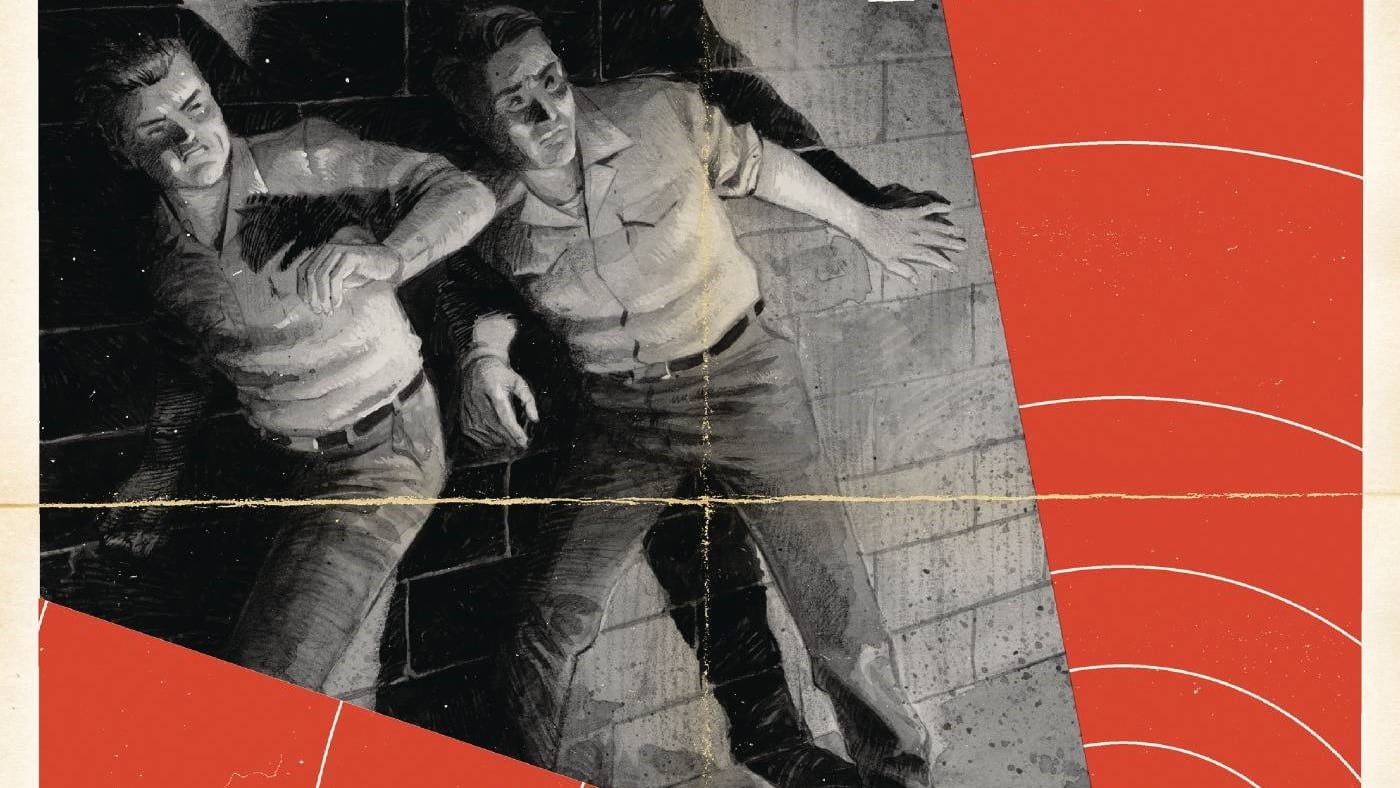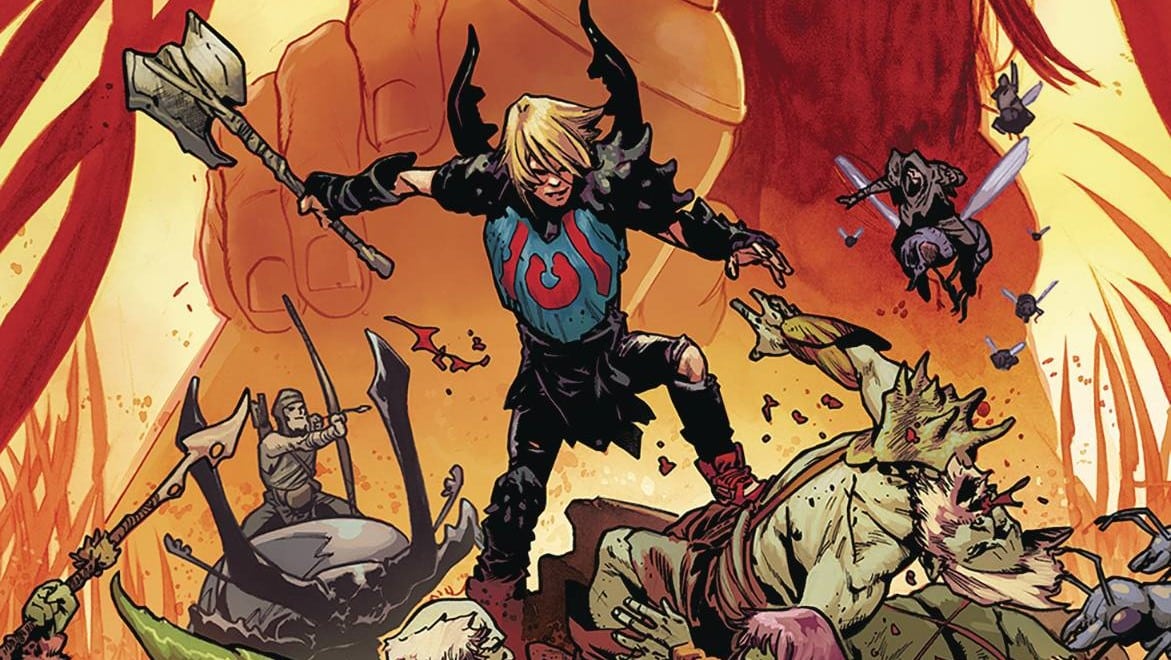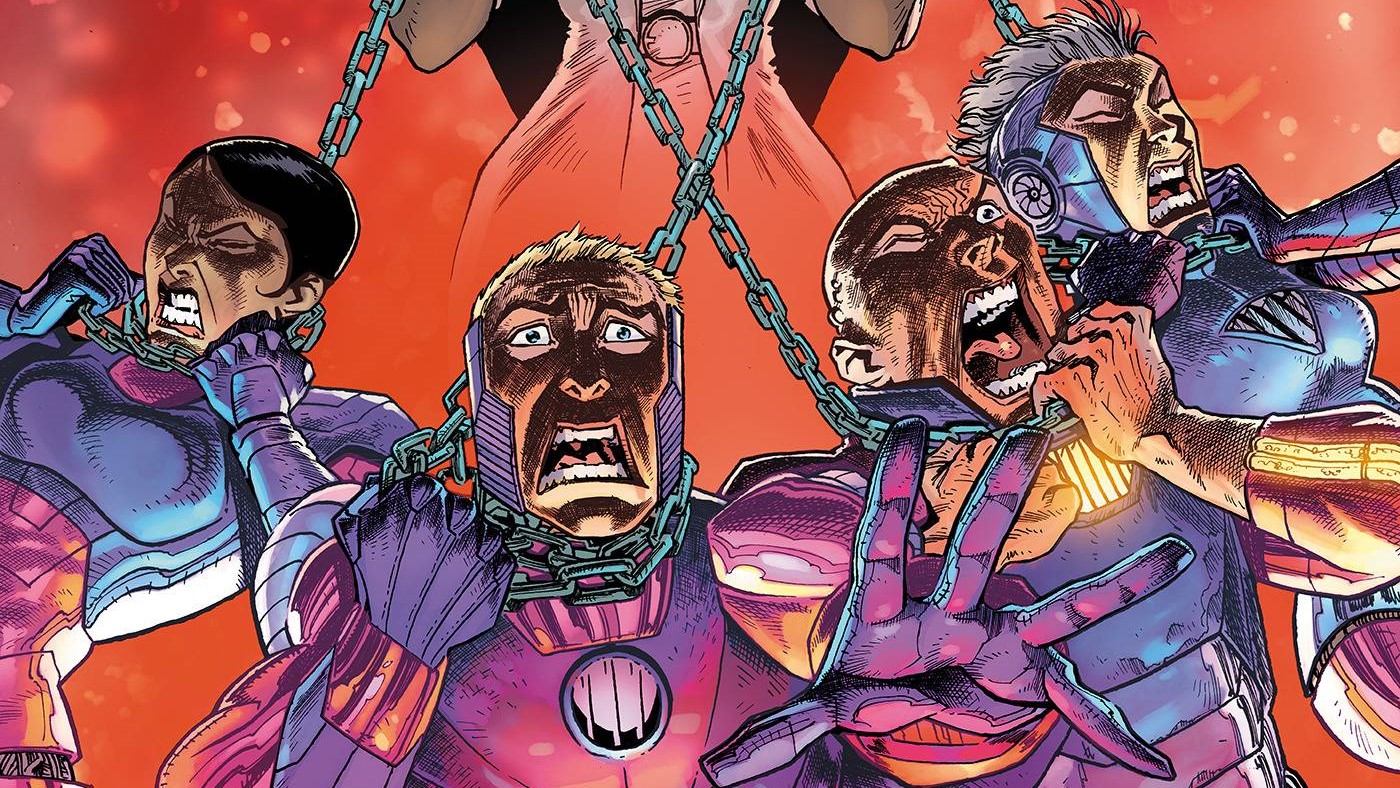Vegetables have taken over the world in Future State: Swamp Thing #1, written by Ram V, penciled by Mike Perkins, colored by June Chung and lettered by Aditya Bidikar.
Vishal Gullapalli: Hey Ari, what do you know about plants?
Ari Bard: Oh boy, I haven’t taken anything to do with biology in eight years, so I’ll just spit out words I remember: xylem, phloem, chloroplasts, stomata, Calvin cycle (or was it Krebs?), and that’s all I got.
VG: Well, it’s OK, because you can throw that all out. We’ve got another “Anatomy Lesson” coming, and our instructors, Ram V and Mike Perkins, are gonna tell you everything about these weird organisms, like how they’ve come to imitate human organs! This is all really important knowledge for when the world ends and our floral overlords are in charge, so I hope you’re taking notes.
Remedial Anatomy
AB: Alright, Vishal, I have my pad and paper ready, and I really appreciate V and Perkins illustrating how to construct a Swamp Thing or other humanoid plant organisms that exist in the future. There’s a lot to appreciate with these interludes. I love the overall feel to them. The sketchy aesthetic and incredibly detailed sensory descriptions remind me of something akin to an architect’s design pad or an inventor’s notebook. There’s such a harmonic blend of natural science and art going on here, and I appreciate its order that counterbalances the chaos of an unknown future.
VG: My first impression was something along the lines of Darwin’s sketches of finch beaks, or Da Vinci’s sketches of mechanisms and their functions. I’ll admit I’m a more sciency than artsy person, and I really appreciated the more scientific veneer of the whole issue — even if it’s all fake, that surface level dressing sets the tone and style of what we’re getting. V’s descriptions of how these plant organisms mimic human anatomy is really interesting as is, but what really brings it together is the sense of wonder you can feel in the narration. Swamp Thing is just as awestruck as we would be watching this miracle of life unfold. And it’s really a miracle, just based on what we can see here.
The style of these anatomy pages is something that really adds to the aesthetic of the book, too — they look like sketches in a notebook (like the one I hope you’re taking notes in, Ari). There’s so much detail in each one, even though they’re uncolored and on blank backgrounds, and it feels like we’re the ones discovering things for the first time.
AB: Definitely, and I think we’re meant to be experiencing this discovery, in part, like how Swamp Thing experienced it for the first time. It took me a few reads to realize this, but I think Swamp Thing himself is creating these organisms. These are Swamp Thing’s notes, and he is the one adding these materials, textures or qualities and performing this construction. However, I disagree in that I don’t think it’s meant to be a miracle at all. Sure, an inventor’s ever elusive grand creation is often completed with an element of luck and wonder involved, but by and large, this was inspiration, genius and science. It was trial and error. I think we’re meant to see that Heather is a creation with an almost divine quality. She is as evolved and as human perhaps as one can get, while Indigo is a much different sort of organism. I don’t think it’s a coincidence that the greener these organisms get, the more human they look. These are a series of trial-and-error projects here, and it just leaves one wondering how this reflects on Swamp Thing himself. Is he a Frankenstien? A Geppetto? Is he something much more benevolent? What do you think, Vishal?
VG: It feels closer to Geppetto, for sure. Swamp Thing is positioned almost as a father figure when interacting with his creations. Now, I’m a sucker for comics about dads, but this feels like more than that — Swamp Thing’s almost their god. He’s the progenitor of an entire civilization, yet he still walks among them. And while I completely believe he wants nothing but the best for this plant world, I have to wonder what will happen when they finally outgrow him.
Planting New Roots
VG: So Swamp Thing’s definitely taking a creator role, but I think I have a different idea of Indigo — maybe his divergence from looking human and even his divergence from being green are a form of rebellion. Swamp Thing clearly cannot control this new world of plants with an iron fist, and I could easily see Indigo willfully choosing to look different from the rest as a rejection of his maker. There’s clear dissent within the ranks — I find it difficult to believe that Indigo is the only one with disdain for Swamp Thing’s affection for humanity — and I wonder if this will parallel every story of humanity creating artificial life that inevitably turns on them.
AB: I think our only difference in thinking here is to the cause of his different color, but I definitely agree with your characterization of Indigo, and I do think he also may be Swamp Thing’s oldest creation. He talks as though he’s known Swamp Thing for longer, and there’s a sense that Indigo may not see Swamp Thing as the same godlike being that the other organisms do. He may not be the only one with disdain for Swamp Thing’s appreciation for humanity, but I do think, from what I’ve seen, that he’s the only one who isn’t afraid. Indigo is a remarkably fascinating character to me in that he’s almost Shakespearean. He reminds me of something akin to a Jester or Fool character that has served under the high-ranking noble for a long time. He speaks in a grand, mocking tone, but he always appears to be honest. Indigo acknowledges and may even respect Swamp Thing, but does not fear or revere him, and that is extremely interesting to me. I look forward to seeing more of this character in any capacity.
VG: I don’t want to get into the habit of speculation, but something you just said made me think — if Indigo’s known Swamp Thing for longer and doesn’t view him as this benevolent creator, it’s very possible he knew Swamp Thing even earlier than the end of humanity. I’m starting to think that Indigo could be someone who knew Swamp Thing back in the DCU proper — maybe the last vestiges of a certain Alec Holland? This is a bit of a stretch, for sure, and I could easily see this being wrong, but it would be a really interesting direction, wouldn’t it?
Either way, he’s definitely positioned as the snake in Eden, the one testing everyone’s faith in Swamp Thing. I don’t think he’s as actively malicious as the literal devil, but he’s definitely challenging the foundations of this society. Something that I find interesting, though, is that Swamp Thing is referred to as “Green” or “Green Father” by his people — does this imply that there might be other such named entities? Does Indigo have a title akin to “Father”? What do you think about the structure of this society, Ari?
AB: That’s a very interesting question, Vishal, and I’m not sure what to think about this society, to be honest. It’s a very nomadic society, moving wherever Swamp Thing seems to go, but more than that, I’m not sure they have a great sense of purpose that we commonly associate with The Green. We are typically used to The Green as an extraordinarily resolute force guided by the Parliament of Trees, its purpose of preserving itself and of thriving superseding all other life and affairs on the planet. Swamp Thing is typically an avatar for this purpose. He has his own free will, and we’ve seen Swamp Thing side with humanity and agents of The Red at times and what consequences result, but in this future, Swamp Thing doesn’t appear to have a larger force watching over him. These organisms seem to only carry allegiance to Swamp Thing and don’t seem to be aware of a larger entity. They call Swamp Thing himself, as you said, so to answer your question, I’m not sure if there are similar entities, but I wonder if the avatars now carry all of the powers and decision-making themselves. Even beyond that I sense very little agency or identity in Swamp Thing or The Green right now. They all have names, and that’s very interesting, but they seem to simply be looking for humans when we’ve only known The Green to exist independently with, if not in opposition to, humanity. It’s definitely something to think about.
VG: I’m really interested in whether we’ll see the other forces of life — The Red, The Gray, The Rot — and if they’ll play a role here or in V’s run proper. Is Mother Red the leader of all animals? What horrific monstrosities could we encounter? I must see more.
Some Meat with Your Vegetation
VG: But for now, it looks like the greater story here is going to be more about what you mentioned, the struggle between the Green and humanity. And it’s a bit of an inauspicious introduction to mankind here, as the first human most of these new plant beings see just killed one of their own. While Father Green’s definitely approaching this human with more compassion than the rest of the members of this society, I can kind of understand his initial violence — a bunch of hulking plant monsters who seem to be not communicating at all is pretty terrifying. I’m really interested in this Obsidian Sun business, though — it looks like that’s Alan Scott’s son, Obsidian, in there, right?
AB: It does appear to be Obsidian, you’re right, and the undying man appears to be the Floronic Man. This complicates humanity a lot further. If he is truly undying, it would suggest that he still has some sort of connection with The Green, although his features appear more like scar tissue than it does plant matter. He also would seem to have little to no regard for The Green, considering he’s planning on plunging the world into darkness, and one thing I do remember from biology is that most plants cannot survive without light. I’m not sure what the agenda is here. As for the first meeting between many of the organisms and humanity, I think that you definitely make a good point about how terrifying everything would probably seem, but there’s also something to be said about how humanity meets so much unfamiliarity with aggression. I think these organisms are exploring an unknown world with a large mix of emotions but primarily curiosity, and it makes humanity seem a lot more hostile.
VG: Yeah, I don’t know if Swamp Thing’s kinder approach is the best tactic, because you’re right — the first response of this person was to be violent, and it seems like mankind has not changed very much from their heyday. Indigo might be making some good points! I really am curious to see how the introduction of the reality of humanity instead of just Swamp Thing’s memories of them might throw his creations into chaos. Obviously the conflict of the story’s going to delve more into this, but I just have so many questions about the civilization and how this STAR Fortress works in relation to the rest of this post-humanity world. This is only a two-issue miniseries, so we probably won’t get all the details we’re looking for, but I’m very interested in how this story will inform the incoming proper Swamp Thing series.







